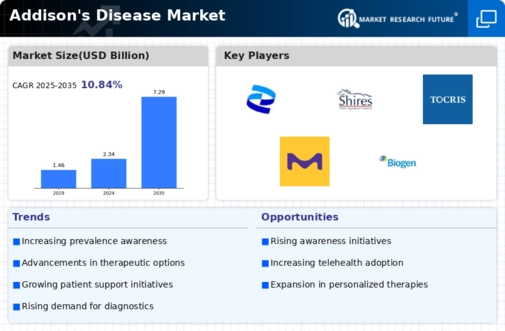Market Growth Chart
Development of Targeted Therapies
The emergence of targeted therapies is reshaping the Global Addison's Disease Market Industry. Pharmaceutical companies are increasingly focusing on developing medications that specifically address the hormonal deficiencies associated with Addison's disease. These targeted treatments aim to improve patient outcomes by providing more effective management of symptoms. As research progresses, new therapies are expected to enter the market, potentially increasing the overall market size. By 2035, the market is anticipated to reach 7.29 USD Billion, driven by the introduction of innovative treatment options that cater to the unique needs of Addison's disease patients.
Advancements in Diagnostic Techniques
Innovations in diagnostic methodologies are significantly impacting the Global Addison's Disease Market Industry. Enhanced imaging techniques and hormonal assays facilitate earlier and more accurate diagnosis of Addison's disease. For instance, the introduction of advanced blood tests allows for the precise measurement of cortisol levels, leading to timely intervention. As diagnostic capabilities improve, healthcare providers can identify patients sooner, which may lead to better management of the disease. This trend is likely to contribute to the market's growth, as early diagnosis correlates with improved patient outcomes and increased demand for treatment options.
Rising Prevalence of Addison's Disease
The Global Addison's Disease Market Industry is experiencing growth due to the increasing prevalence of Addison's disease. This condition, characterized by insufficient production of adrenal hormones, affects approximately 60 to 100 individuals per million globally. As awareness of this rare disorder rises, more patients are being diagnosed, contributing to market expansion. The growing number of diagnosed cases is expected to drive demand for treatment options, thereby enhancing the market's value. In 2024, the market is projected to reach 2.34 USD Billion, reflecting the urgent need for effective therapies and management strategies.
Growing Awareness and Education Initiatives
The Global Addison's Disease Market Industry benefits from increased awareness and educational initiatives aimed at both healthcare professionals and the general public. Organizations and advocacy groups are actively promoting information about Addison's disease, its symptoms, and treatment options. This heightened awareness encourages individuals experiencing symptoms to seek medical attention, leading to more diagnoses. As a result, the market is likely to see an uptick in demand for therapies and management solutions. The ongoing education efforts are crucial in fostering a better understanding of the disease, which may ultimately enhance patient care and treatment adherence.
Increased Investment in Healthcare Infrastructure
Investment in healthcare infrastructure is a critical driver for the Global Addison's Disease Market Industry. Governments and private entities are allocating resources to enhance healthcare facilities, improve access to care, and support research initiatives. This investment is particularly vital in regions where healthcare access is limited, as it enables better diagnosis and treatment of Addison's disease. Improved healthcare infrastructure can lead to a more robust supply chain for medications and therapies, ultimately benefiting patients. As healthcare systems evolve, the market is likely to experience growth, reflecting the positive impact of these investments on patient care.









Leave a Comment